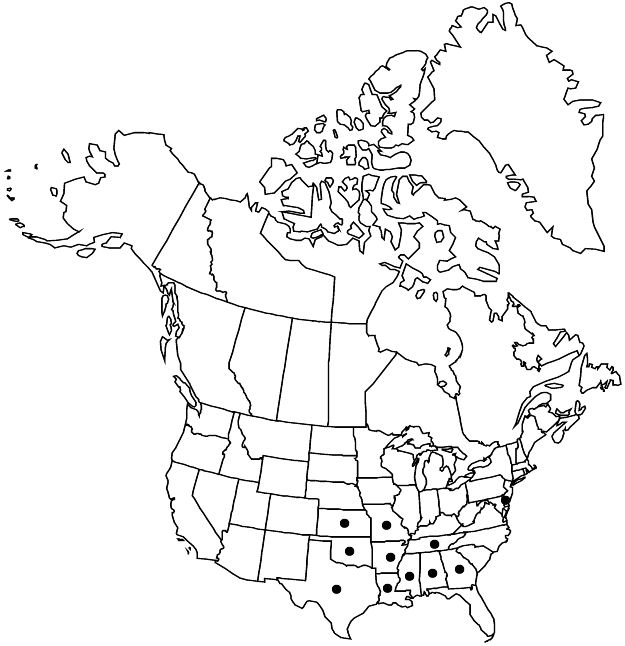Difference between revisions of "Crataegus reverchonii"
Trees & Shrubs 1: 55, plate 28. 1903.
FNA>Volume Importer |
FNA>Volume Importer |
||
| Line 29: | Line 29: | ||
|distribution=sc;se United States. | |distribution=sc;se United States. | ||
|discussion=<p>Varieties 3 (3 in the flora).</p><!-- | |discussion=<p>Varieties 3 (3 in the flora).</p><!-- | ||
| − | --><p>Crataegus reverchonii is differentiated from C. crus-galli by a greater number of styles and pyrenes (except for var. mohrii) and extension-shoot leaves that tend to be suborbiculate. Distinction from a small-leaved form of C. crus-galli from the Edwards Plateau, Texas, needs elucidation. Crataegus stevensiana is sometimes separated out as a variety or species; however, the complex, unresolved variation makes this distinction moot at the moment.</p><!-- | + | --><p><i>Crataegus reverchonii</i> is differentiated from <i>C. crus-galli</i> by a greater number of styles and pyrenes (except for <i></i>var.<i> mohrii</i>) and extension-shoot leaves that tend to be suborbiculate. Distinction from a small-leaved form of <i>C. crus-galli</i> from the Edwards Plateau, Texas, needs elucidation. <i>Crataegus</i> stevensiana is sometimes separated out as a variety or species; however, the complex, unresolved variation makes this distinction moot at the moment.</p><!-- |
| − | --><p>The principal variation within Crataegus reverchonii is between smaller-statured, smaller-leaved, smaller-fruited, more-styled, xeromorphic plants of the southwest (var. reverchonii), and larger-leaved, large-flowered, fewer-styled plants of the mid latitude, eastern United States (var. palmeri). Variety mohrii is intermediate.</p> | + | --><p>The principal variation within <i>Crataegus reverchonii</i> is between smaller-statured, smaller-leaved, smaller-fruited, more-styled, xeromorphic plants of the southwest (<i></i>var.<i> reverchonii</i>), and larger-leaved, large-flowered, fewer-styled plants of the mid latitude, eastern United States (<i></i>var.<i> palmeri</i>). Variety mohrii is intermediate.</p> |
|tables= | |tables= | ||
|references= | |references= | ||
| Line 73: | Line 73: | ||
|publication year=1903 | |publication year=1903 | ||
|special status=Endemic;Selected by author to be illustrated | |special status=Endemic;Selected by author to be illustrated | ||
| − | |source xml=https://jpend@bitbucket.org/aafc-mbb/fna-data-curation.git/src/ | + | |source xml=https://jpend@bitbucket.org/aafc-mbb/fna-data-curation.git/src/8f726806613d60c220dc4493de13607dd3150896/coarse_grained_fna_xml/V9/V9_901.xml |
|subfamily=Rosaceae subfam. Amygdaloideae | |subfamily=Rosaceae subfam. Amygdaloideae | ||
|tribe=Rosaceae tribe Gillenieae | |tribe=Rosaceae tribe Gillenieae | ||
Revision as of 18:20, 18 September 2019
Shrubs, 10–30(–80) dm. Stems: twigs: new growth glabrous, 1-year old dark gray; thorns on twigs slightly reflexed, 2-years old blackish, usually stout, 3–6 cm. Leaves: petiole 2–5 mm, length 7–11% blade, glabrous, eglandular; blade (on extension shoots) ± orbiculate to broadly elliptic, (on short shoots) ± orbiculate to broadly oblong-elliptic, 2–6 cm, very coriaceous, base broadly cuneate, lobes 0, margins serrulate in distal 1/2, venation semicamptodromous, veins 5 or 6 per side, apex subacute to obtuse, surfaces sparsely hairy young, glabrescent. Inflorescences 8–15-flowered; branches usually glabrous; bracteoles linear, small, margins short-stipitate-glandular. Flowers 8–12 mm diam.; hypanthium glabrous, sometimes slightly pilose; sepals 4 mm, margins subentire, abaxially glabrous; stamens 10–15(–20), anthers cream, rose, or red; styles (2 or)3–5. Pomes red to orange-red, suborbicular, 10 mm diam., glabrous; sepals persistent, patent or reflexed; pyrenes (1–)3–5.
Distribution

sc, se United States.
Discussion
Varieties 3 (3 in the flora).
Crataegus reverchonii is differentiated from C. crus-galli by a greater number of styles and pyrenes (except for var. mohrii) and extension-shoot leaves that tend to be suborbiculate. Distinction from a small-leaved form of C. crus-galli from the Edwards Plateau, Texas, needs elucidation. Crataegus stevensiana is sometimes separated out as a variety or species; however, the complex, unresolved variation makes this distinction moot at the moment.
The principal variation within Crataegus reverchonii is between smaller-statured, smaller-leaved, smaller-fruited, more-styled, xeromorphic plants of the southwest (var. reverchonii), and larger-leaved, large-flowered, fewer-styled plants of the mid latitude, eastern United States (var. palmeri). Variety mohrii is intermediate.
Selected References
None.
Lower Taxa
Key
| 1 | Short-shoot leaf blades 4–6 cm; flowers 10–12 mm diam.; styles (2 or)3. | Crataegus reverchonii var. palmeri |
| 1 | Short-shoot leaf blades 2–3.5 cm; flowers 8–12 mm diam.; styles 3–5 | > 2 |
| 2 | Flowers 8–10 mm diam.; inflorescences usually glabrous; w of Mississippi River. | Crataegus reverchonii var. reverchonii |
| 2 | Flowers 12 mm diam.; inflorescences often pilose; e of Mississippi River. | Crataegus reverchonii var. mohrii |